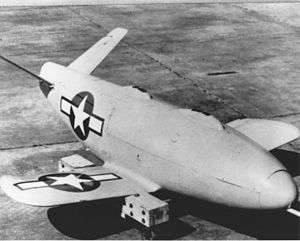LBD Gargoyle
The LBD-1 Gargoyle (later KSD-1, KUD-1 and RTV-N-2) was an American air-to-surface missile developed during World War II by McDonnell Aircraft for the United States Navy. One of the precursors of modern anti-ship missiles, it was extensively used as a test vehicle during the late 1940s.
| Gargoyle | |
|---|---|
 LBD-1 at Mojave in 1946. | |
| Type | anti-ship missile / guided bomb |
| Place of origin | United States |
| Service history | |
| In service | 1945-1950 |
| Used by | United States Navy |
| Wars | World War II (test only) |
| Production history | |
| Manufacturer | McDonnell Aircraft |
| Produced | 1944-1947 |
| No. built | 200 |
| Specifications | |
| Mass | 1,500 lb (680 kg) |
| Length | 10 ft 1 in (3.07 m) |
| Warhead | armor-piercing bomb |
| Warhead weight | 1,000 lb (450 kg) |
| Engine | Aerojet 8AS1000 JATO bottle 1,000 lbf (4.4 kN) for 8 sec |
| Wingspan | 8 ft 6 in (2.59 m) |
| Propellant | solid fuel |
Operational range | 5 mi (8.0 km) |
| Maximum speed | 600 mph (970 km/h) |
Guidance system | radio command guidance |
Design and development
Following the successful use of the German Henschel Hs 293 and Fritz-X guided bombs in combat during 1943, a requirement was issued by the U.S. Navy that October for a guided weapon based on similar principles.[1] Assigned as part of the Glomb ("glide bomb") project,[2] the weapon was code-named "Gargoyle", and following the completion of design work in the summer of 1944,[1] McDonnell Aircraft was awarded a contract for a test-and-evaluation production run of 400 Gargoyles in September, given the designation LBD-1.[3]
Intended for carriage by carrier-based aircraft, Gargoyle was of fairly conventional small-aircraft design, weighing 1,500 pounds (680 kg) when ready for launch, and fitted with a low-mounted 8-foot-6-inch (2.59 m) wing and v-tail attached to a streamlined fuselage, 10 feet 1 inch (3.07 m) in length,[3] containing a 1,000-pound (450 kg) armor-piercing bomb.[1] An Aerojet solid-propellant rocket, of the JATO type and providing 1,000 lbf (4.4 kN) of thrust,[4] was fitted to provide terminal boost to 600 miles per hour (970 km/h), and guidance was by radio command, the missile being tracked visually via a flare mounted in the tail section.[1] The effective range of Gargoyle was 5 miles (8.0 km) when released at an altitude of 27,000 feet (8,200 m).[5]
Operational history
Gargoyle's armor-piercing capability and the fact that it could be carried by carrier-based aircraft allowed development to continue despite late-war rationalizations of missile projects,[6] and following delivery of the first weapons to the Navy at the end of 1944 flight trials were begun in March 1945.[3] Difficulties encountered during the test program meant that by July only five of fourteen tests were considered to be "satisfactory" by the Navy,[3] and the first fully successful flight did not occur until July 1946. By then Gargoyle had been redesignated twice, to KSD-1 in October 1945 and in early 1946 to KUD-1 as a pure research effort.[1] The aerodynamic design of Gargoyle was, however, considered to be satisfactory from an aerodynamic standpoint; however, with the end of the war, the contract was reduced first to 375 missiles,[3] and then to 200, with the production run being completed by the summer of 1947.[1] That fall the Gargoyle was redesignated again under the U.S. Navy's new missile designation system, first to RTV-2 and then to the definitive RTV-N-2 in 1948. Testing continued through December 1950, Gargoyle being used to trial equipment and procedures for the Navy's other missile programs at the Marine Corps Auxiliary Air Station Mojave,[7] before the program was finally terminated, the remaining RTV-N-2s being designated for scrapping.[1]
Surviving aircraft
A Gargoyle, donated to the National Air and Space Museum in 1974, is on display at the Steven F. Udvar-Hazy Center.[4]
References
Citations
- Parsch 2003
- Parsch 2005
- Ordway and Wakeford 1960
- "Gargoyle Missile". National Air and Space Museum. Smithsonian Institution. 26 September 2016. Retrieved 2017-12-23.
- Yenne 2006, p. 24.
- Friedman 1982, p. 201.
- Jacobs and Whitney 1962, p. 69.
Bibliography
- Friedman, Norman (1982). U.S. Naval Weapons: Every gun, missile, mine, and torpedo used by the U.S. Navy from 1883 to the present day. Annapolis, MD: Naval Institute Press. ISBN 978-0-87021-735-7.
- Jacobs, Horace; Eunice Engelke Whitney (1962). Missile and Space Projects Guide 1962. New York: Springer Science+Business Media. ISBN 978-1-4899-6967-5.
- Ordway, Frederick Ira; Ronald C. Wakeford (1960). International Missile and Spacecraft Guide. New York: McGraw-Hill. ASIN B000MAEGVC.
- Parsch, Andreas (9 March 2005). "LB Series (LBD, LBE, LBP, LBT)". Directory of U.S. Military Rockets and Missiles, Appendix 1: Early Missiles and Drones. Designation-Systems. Retrieved 2017-12-23.
- Parsch, Andreas (4 February 2003). "McDonnell LBD/KSD/KUD/RTV-N-2 Gargoyle". Directory of U.S. Military Rockets and Missiles, Appendix 1: Early Missiles and Drones. Designation-Systems. Retrieved 2017-12-23.
- Yenne, Bill (2006). Secret Gadgets and Strange Gizmos: High-Tech (and Low-Tech) Innovations of the U.S. Military. Minneapolis, MN: Zenith Press. ISBN 978-0760321157.